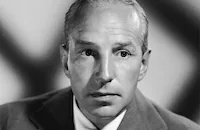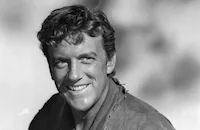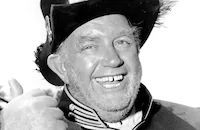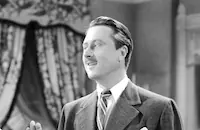Island in the Sky
Brief Synopsis
Cast & Crew
William A. Wellman
John Wayne
Lloyd Nolan
Walter Abel
James Arness
Andy Devine
Film Details
Technical Specs

Synopsis
During World War II, Capt. Dooley, a commercial airline pilot serving in the Army Air Transport, experiences bad weather conditions during a flight. Unable to get his bearings, he crash-lands the four-engine Corsair on a frozen lake in an uncharted area of Labrador. Dooley takes stock during the night, as the temperature drops to seventy below, noting that he and his crew have thirty gallons of gas left to run the generator and six days of rations. Realizing that panic and brutal temperatures may diminish their mental clarity, Dooley prepares to keep up his men's morale. Miles away, on Presque Island, Maine, Army Col. Fuller calls in all available pilots for a search and rescue operation, and news of Dooley's predicament brings many volunteers from the close-knit fraternity of pilots, including Dooley's friend Moon. However, bad weather conditions and poor visibility hinder the team's efforts. In the days that pass, temperatures at the crash site rise no higher than forty below zero. D'Annunzia, Dooley's radioman, nurses the Corsair's dying generator. After he reports that the generator has little power left to transmit messages for help, the young navigator, Murray, and engineer Stankowski take turns cranking a hand-operated generator, which provides only a weak signal. Although the rescue team receives a transmission from Dooley's crew, they are unable to make out the stranded crew's bearings. On the ground, Dooley and his men prepare for a brutal storm and not until evening does Dooley realize that co-pilot Lovatt has slipped away alone, against direct orders, to hunt for game. Dooley and the men search for Lovatt, but find it difficult to maintain a sense of direction in the falling snow and darkness. They call out and shoot into the air to give him a sound to follow, but Lovatt has already succumbed to the bitter cold, hallucinating that he is riding a carousel with his girl friend, which is across a fairway from a shooting gallery. In reality, Lovatt is wandering circles through the snow and finally drops, and the next day Dooley and the crew find his body several yards from the aircraft. As they bury Lovatt, rescue planes pass over, but fail to see them. However, Moon, who is piloting one of the planes, senses that the downed crewmen are near and has his radioman telegraph a message in Morse code, suggesting that Dooley build a large fire to mark his location. Dooley's men get the message and prepare a bonfire with what they can find, but their attempts to radio Moon fail. As night approaches and an ice storm makes flying hazardous, the rescue team returns reluctantly to Presque Island, again passing over the stranded men below. Aware that a low pressure weather system is forming and will soon halt the search for several days, Fuller and the flyers debate whether to use the time they have left to search in a new area or return to areas they have already flown over. After Moon convinces them to re-comb previously explored areas, Fuller orders a night search and the pilots return to the skies for a last-ditch effort to save their colleagues. In the air, they retrieve a weak radio message from Dooley, asking the planes to "return to the same place," and they attempt to retrace their previous search flights. Unaware that his message has been received, Dooley, who hides the panic he feels, has the men crank the generator to transmit radio signals and shoots flares and pistols. Eventually, his activities are spotted by the searchers, who are nearly out of gas after flying all night. After dropping off emergency supplies and a note promising that ski planes will be sent to rescue them, the search planes return to Presque Isle.

Director

William A. Wellman
Cast

John Wayne

Lloyd Nolan

Walter Abel

James Arness

Andy Devine

Allyn Joslyn

James Lydon

Harry Carey Jr.
Hal Baylor
Sean Mcclory

Wally Cassell

Gordon Jones
Frank Fenton
Robert Keys
Sumner Getchell

Regis Toomey

Paul Fix
Jim Dugan
George Chandler

Louis Jean Heydt

Bob Steele

Darryl Hickman

Touch Connors

Carl Switzer
Cass Gidley

Guy Anderson
Tony De Mario

Ann Doran
Dawn Bender
Phyllis Winger
Tim Wellman
Mike Wellman
Johnny Indrisano

William A. Wellman
Tom Irish
Crew
James Basevi
Richard Birnie
Ed Borschell
Don Christy
William Clothier
Earl Crain Sr.
Ralph Dawson
Nate H. Edwards
Robert Fellows
Sam Freedle
Ernest K. Gann
Ernest K. Gann
Ralph Hurst
Joseph La Bella
Andrew Mclaglen
Richard Morrison
William Mueller
Emil Newman
Web Overlander
Archie Stout
Carl Walker
John Wayne
Alex Weldon

Photo Collections
Film Details
Technical Specs

Articles
Island In the Sky - Island in the Sky
The story kicks into high gear almost immediately, when a DC-3 aircraft makes a crash landing in Labrador, so far north that the area is barely on the map. Although this happens during World War II, the pilot and crew are civilians, doing their bit for the American military. Having survived the forced landing with no injuries, they quickly realize that the hard part is just beginning. Their food supply is miniscule, and their only heat is what they can coax from a modest wood fire. Worst of all, there's hardly any power to send distress signals on their rapidly fading radio. Their chances for survival are iffy at best.
Meanwhile, a small group of military flyers gather to plan a rescue mission, painfully aware they're caught in an excruciating dilemma. Too much caution means the downed aviators will freeze to death before help arrives; too much haste means they could fly right over the stranded men without seeing them, which actually happens at one point. On top of all this, the rescuers know and love the men they're searching for-especially Dooley, the greatly respected pilot-but they can't let emotions cloud their intellect as they make decisions that could mean life or death.
Island in the Sky was Gann's first major novel, developed from notes and short stories he jotted down while flying back and forth across the North Atlantic during World War II, when many commercial pilots like him were absorbed into military support roles. Hollywood had been interested in the book well before Wellman and Wayne got involved with it; both Twentieth Century Fox and Stanley Kramer had optioned it without putting it into production. Wellman discovered it when a literary agent gave him a copy during a golf game, and it was certainly up Wellman's alley: He had flown with the Lafayette Escadrille during World War I, earning the nickname Wild Bill, and his 1927 aviation epic Wings had won the first-ever Academy Award for best picture.
In addition to the aviation theme of Gann's novel, Wellman was drawn to its basic situation, with a few characters trapped by circumstances and isolated from society-a subject he'd treated in his classic 1943 western The Ox-Bow Incident and other films. He expressed his enthusiasm to Warner Bros., where he was moving after a stint at MGM, and to Wayne, who made it the first project of the Batjac production company he and partner Robert Fellows had recently formed.
They hired Gann to write the screenplay, and Wellman also made Gann the technical adviser, which by Wellman's definition meant actually directing parts of the story where authenticity was essential. They hunted up locations in Northern California for the snowbound scenes, but commenced filming with the airborne material shot by (uncredited) cinematographer William H. Clothier, using what Wellman later described as "rather beat-up DC-3s" from a Kansas surplus dump. Then came the dramatic scenes, photographed by Wellman regular Archie Stout.
Numerous reviewers have found Island in the Sky a flawed adventure yarn, faulting the sometimes preachy tone of its narration and the unnecessary flashbacks that interrupt the story's momentum. Another problem is the score, by Emil Newman and uncredited Hugo Friedhofer, which occasionally lapses into "inspirational" syrup.
But plenty of moviegoers agree with David Mamet that Island in the Sky is one of the great flying films. Its most consistent asset is first-rate acting from the entire cast, starting with Wayne, who gives one of the subtlest, most nuanced performances of his remarkable career as pilot Dooley, a strong yet introspective leader who's acutely aware of the responsibility he bears for the safety and survival of his crew. Lloyd Nolan is excellent as thoughtful Captain Stutz of the rescue team, and Andy Devine is a revelation, making the chunky rescue pilot Willie Moon into a three-dimensional human being without one excess word or gesture. The only real let-down is James Arness as a southern farmer who can't wait to trade his airplane for a Carolina mule; in addition to his clunky acting, he's saddled with the film's worst dialogue scenes.
Wellman was among the fine journeyman directors of Hollywood's studio era, turning out good, sometimes important movies-including The Public Enemy (1931), Wild Boys of the Road (1933), Nothing Sacred (1937), the 1937 version of A Star Is Born, The Story of G.I. Joe (1945), and The High and the Mighty (1954), another Gann project-without achieving auteur status in the eyes of most critics. He marched to his own drummer as much as the system allowed, even when his Wild Bill personality scared or alienated his colleagues. "I'm a loner," he told me in a 1975 interview just months before his death. "In fact," he added, "I don't think I'm a very lovable guy." But being lovable is beside the point when you have the talent and temperament to make a picture as solid and engrossing as Island in the Sky.
Director: William A. Wellman
Screenplay: Ernest K. Gann
Cinematography: Archie Stout
Film editing: Ralph Dawson
Production design: James Basevi
Music: Emil Newman
Cast: John Wayne (Capt. Dooley), Lloyd Nolan (Capt. Stutz), Walter Abel (Col. Fuller), James Arness (Mac McMullen), Andy Devine (Willie Moon), Allyn Joslyn (J.H. Handy), Jimmy Lydon (Murray), Harry Carey, Jr. (Ralph Hunt), Hal Baylor (Stankowski), Sean McClory (Frank Lovatt), Wally Cassell (D'Annunzia), Gordon Jones (Walrus), Regis Toomey (Sgt. Harper), Paul Fix (Wally Miller), Darryl Hickman (Swanson), Carl Switzer (Sonny Hopper). BW-109m.
by Mikita Brottman and David Sterritt

Island In the Sky - Island in the Sky
Sean McClory (1924-2003)
Born on March 8, 1924 in Dublin, Ireland, he became a leading man at the famous Abbey Theatre in the early '40s and relocated to the United States shortly after World War II. His first roles were small bits as a police officer in two RKO quickies: Dick Tracy's Dilemma and Dick Tracy Meets Gruesome (both 1947). He eventually graduated to more prestigious pictures like The Glass Menagerie (1950), Les Miserables (1952) and John Ford's The Quiet Man (1952).
After a few more supporting roles in quality pictures: Niagara (1953); the sci-fi chiller Them! (1954); and for John Ford again in The Long Gay Line (1955), McClory turned to television. He kept busy for several years with guest roles in a variety of popular shows: Bonanza, Wagon Train, Rawhide, Gunsmoke, The Outer Limits (1964) and countless others. By the mid-'60s, McClory became slightly more heavy-set, and began tossing off variations of jovial, "oirish" blarney for, yet again John Ford in Cheyenne Autumn (1964); and in a string of Disney pictures: Follow Me, Boys! (1966, his best role, a moving performance as the alcoholic father whose behavior alienates his son, played by a 15-year old Kurt Russell); The Happiest Millionaire (1967), and The Gnome-Mobile (1967), before he returned to television. His final role was in John Huston's acclaimed Irish opus The Dead (1987). He is survived by his wife, Peggy Webber McClory.
by Michael T. Toole
Sean McClory (1924-2003)
Quotes
Trivia
Notes
The opening title credit reads: "William A. Wellman's Island in the Sky." Voice-over narration spoken by director William A. Wellman begins, "This is a story about professional pilots and their special, guarded world, their island in the sky." After describing the close kinship among all pilots and their lifetime devotion to flying, narration continues intermittently throughout the film. According to the Hollywood Reporter review, the preview at the Hollywood Paramount "benefited by the use of widescreen." Neither Hollywood Reporter production charts nor other reviews mentioned the widescreen format. The Variety review reported that a "brief intermission" was necessitated by the new stereophonic sound equipment.
According to a Daily Variety news item, in January 1950 Robert Stillman Productions bought the rights to the novel, Island in the Sky, and the novel's author, Ernest K. Gann, planned to collaborate with Seton I. Miller on a screenplay. An April 1951 Los Angeles Times news item reported that Frank P. Rosenberg would produce the film and Richard Widmark would star. However, Stillman dropped his plans to make the film, according to a December 1952 Daily Variety news item, and Wayne-Fellows Productions acquired the rights and made tentative plans to shoot on location in Canada. Wellman, who had directed several films about pilots, and was himself a former pilot with the Lafayette Flying Corp during World War I, was chosen to direct. In 1953, Gann's novel was mentioned in Los Angeles Daily News and Hollywood Reporter news items, when an Ohio State Penitentiary inmate plagiarized verbatim and sold the book to a publishing house, before his deception was discovered.
Besides writing the screenplay, Gann, then a commercial pilot for Transocean Airlines and a veteran of the Air Transport Command at Presque Island, ME, served as the film's technical director and piloted a plane for the 2d unit, according to Warner Bros. publicity material and a January 1953 Hollywood Reporter news item. Four other pilots also assisted in the making of the film, according to studio publicity materials. Portions of the film were shot on location at Donner Lake, near Truckee, CA, according to the Variety review, and studio publicity material mentioned that California Forestry Service rangers felled trees to make airplane runways in the four foot deep snow there. A January 1953 Hollywood Reporter news item added that background shooting took place in San Francisco.
Ann Doran, Dawn Bender and Phyllis Winger appeared in the film, respectively, as wives and a girl friend. Except for Doran, who is shown holding a telephone conversation with Devine, the women appear only in brief flashbacks. Wellman's sons, Tim and Mike, aged eleven and five respectively, played the sons of Andy Devine's character, "Moon," according to Warner Bros. publicity material. Although their appearance in the film has not been confirmed, Hollywood Reporter news items add Dick Walsh, Fred Graham and Paul Grant to the cast, while a modern source adds Gene Coogan. Although only Emil Newman is credited onscreen and no songs are heard in the film, modern sources list Hugo Friedhofer as a collaborating composer-lyricist. A radio adaptation of the film was broadcast on January 11, 1955 on Lux Radio Theatre, starring Dick Powell as "Dooley."

Miscellaneous Notes
Released in United States Summer August 1953
Released in United States Summer August 1953














